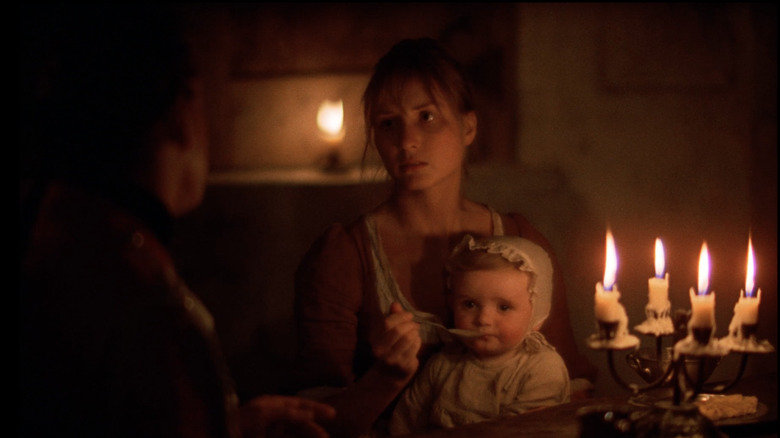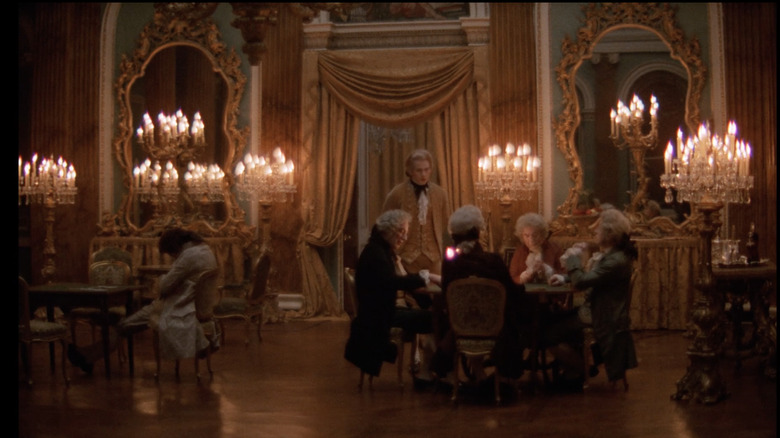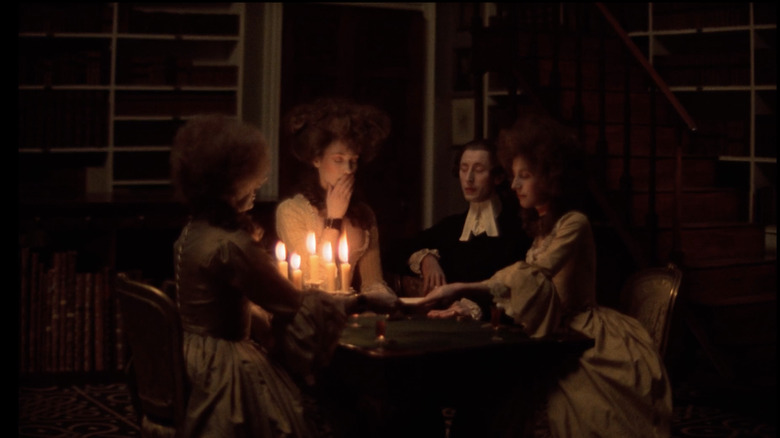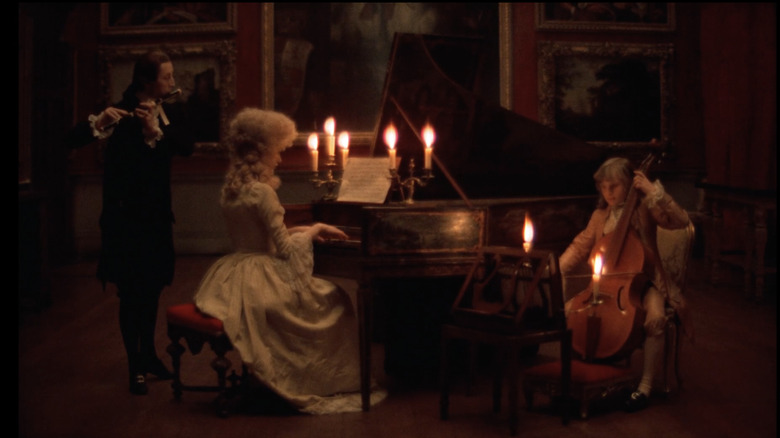How Stanley Kubrick Filmed Barry Lyndon By Candlelight
Despite being known for his unrivaled penchant for perfectionism, things did not always gone as planned for auteur director Stanley Kubrick. No facet of his career is more emblematic of this truth than 1975's "Barry Lyndon," which itself only came to fruition due to the director's failed attempt to make an epic biopic about Napoleon Bonaparte. However, Kubrick seemed to singularly relish in this loosened grip of control, opting to have the entirety of the film lit only by natural sources of light, which included utilizing candlelight in all of the interior shots. Predictably, this process required innovation, meticulousness and a unique vision — all of which Kubrick managed to conjure for what remains one of his most aesthetically stunning films, even in the face of masterworks such as "2001: A Space Odyssey," "A Clockwork Orange" and "Spartacus."
Let's get down to the nitty-gritty of how "Barry Lyndon"'s candlelight filming was achieved, why it was so revolutionary, and, of course, how it created one of the most gorgeously realized aesthetics in cinematic history.
First, Some Context
For those who might not be entirely familiar with the movie, "Barry Lyndon" is Kubrick's tenth feature film, following 1971's dystopian "A Clockwork Orange" and preceding his 1980 horror hit "The Shining." It's adapted from William Makepeace Thackery's novel "The Luck of Barry Lyndon," which follows the rise of an otherwise ordinary Irishman through the ranks of 18th century high society. It's clear that his downfall is imminent, but Barry's (Ryan O'Neal) journey is engrossing no matter what rung on the ladder of social hierarchy he occupies.
Even as far back as during his helming of "2001," Kubrick had been anticipating working on a different kind of 18th century period film. For years, he had been conducting research, scouting locations, and coordinating the logistics for filming his dream Napoleon Bonaparte biopic, which ultimately was scrapped after the financial failure of Sergei Bondarchuk's "Waterloo" (1970). While many argue that Kubrick's unrealized Napoleon picture is one of cinema's great tragedies, countless others have argued that "Barry Lyndon" achieves everything that Kubrick originally sought to do with "Napoleon." Particularly when it comes to the director's fascination with the prospect of lighting a film entirely by candlelight, a change in subject didn't appear to hinder him at all.
For the better part of a year (eight and a half months to be precise), Kubrick shuttled his cast and crew back and forth from England to Ireland, but the actual technical finesse of capturing candlelight in "Barry Lyndon" required expertise beyond the realm of basic film photography — and Kubrick secured some major help before he even got started on filming.
How Did He Do It?
Back when Kubrick was conceiving "Barry Lyndon," the idea of lighting an entire scene solely using candles was just short of impossible. There literally was not a lens in existence capable of capturing such low light — that is, until NASA commissioned 50mm f/0.7 lenses with the purpose of capturing still images of the dark side of the moon. Kubrick immediately snatched up a few lenses, and with the help of American technical innovator Ed DiGiulio the pair managed to fit the lenses for motion picture cameras. With a few other modifications to address issues with depth of field, blurriness, and the added benefit of push-developing, it appears Kubrick manifested the miracle of capturing candlelight without sacrificing the quality of the picture itself.
In a conversation with American Cinematographer Magazine, D.P. John Alcott reveals even more about the precise way he lit candlelight scenes while filming "Barry Lyndon" with this newfound lens:
"In the sequence were Lord Ludd and Barry are in the gaming room and he loses a large amount of money, the set was lit entirely by the candles, but I had metal reflectors made to mount above the two chandeliers, the main purpose being to keep the heat of the candles from damaging the ceiling. However, it also acted as a light reflector to provide an overall illumination of toplight."
While Kubrick's decision to film almost exclusively by candlelight (as deduced from the quote above, there was certainly some added lighting trickery to these shots), the decision also called for a newfound relinquishing of perfectionist control that remains a hallmark of the director's filmic practice.
Kubrick's Meticulous Process Is Heightened
Somewhat notorious for pushing his actors to the fringes of sanity due to his insistence of multiple takes and back-breaking hours (to be frank, Shelly Duvall deserved better), Kubrick directed his efforts of control toward technical aspects of "Barry Lyndon" far more than toward the actors involved — though they were not entirely free of the burden of countless takes and extensive hours.
In a 2014 interview with Filmmaker Magazine, O'Neal spoke to the meticulous nature of the lighting and how this brought about another layer of time-consuming measured taken by cast and crew. "The problem was that if we didn't get the take we had to blow all the candles out and start with new ones," he explained. "And the candles all had three wicks, that was our trick. So it wasn't easy to blow them out!"
Similarly, a supplementary feature on the latest Criterion reissue of "Barry Lyndon" offers added details on how Kubrick's highly specific vision was achieved, namely through additional efforts when it came to taming the principle fickle light source.
"You had an enormous amount of smoke," recalls focus puller Douglas Milsome in the segment. "When you got to the scene, you would open all of the windows...extract all the dirt and dust."
"With so many candles, I mean, there was no oxygen in the room," continues gaffer Lou Bogue. "So you were ready to fall asleep," he says while appearing to nod off himself.
The physical presence of the candles was certainly felt by personnel on set, but their presence is even more heightened in the final product on-screen.
"Candlelight don't travel very far," notes Bogue. "There's an illusion...The four of five candles you see, behind them are 20 candles...But you don't see them."
Despite utilizing grand light sources — such as 70-candle chandeliers — it is often the most intimate scenes illuminated by candlelight that are the most extravagant in their allure, such as the sparse scene of a band playing gorgeous musical notes as candelabras are strewn about a grand piano.
The End Result
Kubrick's artistic intent is fully realized in "Barry Lyndon," which endures as one of the most gorgeously styled and shot period films of all time. With digital technology, the feat of filming by candlelight is now wholly possible — though arguably a moot effort when this film already exists. With the gorgeous texture of film grain capturing the soft, warm light of a candle's flame (allegedly, the film utilized about 500 candles during the entirety of the shoot), Kubrick instilled his film with aesthetic grandeur alongside an engrossing narrative, making for a film that is teeming with style, substance and powered by space-age technology.




